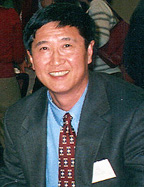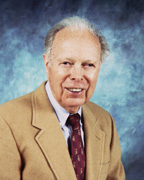 |
Li Li Ji, Ph.D. |
It happened in 1996, as the two men waited to board an airplane in San Francisco. They were both heading to a gerontology conference in Australia.
One was an octogenarian from Omaha (Denham Harman, M.D., Ph.D.). The other — a native of Shanghai, China (Li Li Ji, Ph.D.) – was more than 30 years younger. But, they shared a common passion – an insatiable desire to understand why humans age.
“I knew of Dr. Harman’s work,” said Dr. Ji. “I had been a longtime admirer of his free radical theory.”
|
|
Forging a friendship
The two men talked extensively, sharing their expertise freely. Four years later, they met again at a conference in Korea. Two years ago, Dr. Ji was with Dr. Harman in Madison, Wis., when Harman received two awards for his aging research.
Now Dr. Ji, who is professor and chairman of the department of kinesiology at the University of Wisconsin-Madison, is coming to Omaha today (April 25) to deliver the second annual Denham Harman, M.D., Ph.D., Lectureship in Biomedical Gerentology.
“This is a big deal for me,” Dr. Ji said. “I’m so proud to come to Dr. Harman’s hometown and give this lecture.”
Theory holds true
An exercise physiologist and biochemist, Dr. Ji is a huge fan of Dr. Harman. He said, “If there is a Nobel Prize set up for aging research, Dr. Harman would be the logical choice. Everyone would agree that his work really revolutionized aging research and put the free radical theory at the forefront. With every concrete development in aging, his theory holds true.”
Dr. Harman’s research on aging is centered around the theory he proposed in 1954 — that free radicals, highly reactive molecules freed in the normal chemical processes of living, cause aging and disease through their destructive actions in cells and tissues. At first, his theory was ridiculed and dismissed by many in the scientific community. It finally gained acceptance in the 1980s.
Making the case for antioxidants
Dr. Harman, 87, an internist and chemist and a professor emeritus in UNMC’s internal medicine department, believes people need extra supplies of antioxidant vitamins such as vitamin E, vitamin C, beta carotene and the mineral selenium, as these antioxidants neutralize free radicals and slow the aging process.
 |
Denham Harman, M.D., Ph.D. |
Exercise and aging
During today’s noon lecture at the Eppley Science Hall Amphitheater, Dr. Ji will discuss his research on exercise and its relationship between free radical generation and aging.
“Exercise and aging are very closely related,” Dr. Ji said. “Both are affected by free radicals. It raises the question – should we exercise as we age?
It is a complicated relationship, but it has been proven that regular progressive exercise as we get older is good for you. However, you must keep in mind that exercise costs you antioxidants. That’s why it’s important to maintain a proper diet and supplement your diet with an intake of antioxidants.”
More on Dr. Ji
Dr. Ji supplements his diet with a combination of vitamin E, oatmeal and ginseng. Although ginseng is a famous Chinese herbal medicine, Dr. Ji said that Wisconsin exports 90 percent of the world’s ginseng.
Dr. Ji earned his undergraduate degree from East China Normal University in Shanghai, China, and his master’s and doctorate degrees from the University of Wisconsin-Madison. From 1987 to 1993, he served on the faculty at the University of Illinois at Urbana-Champaign. He joined the University of Wisconsin-Madison faculty in 1994 as associate professor and chairman of the department of kinesilogy and was elevated to professor in 1997.
The Harman Lectureship is held in conjunction with internal medicine’s grand rounds.